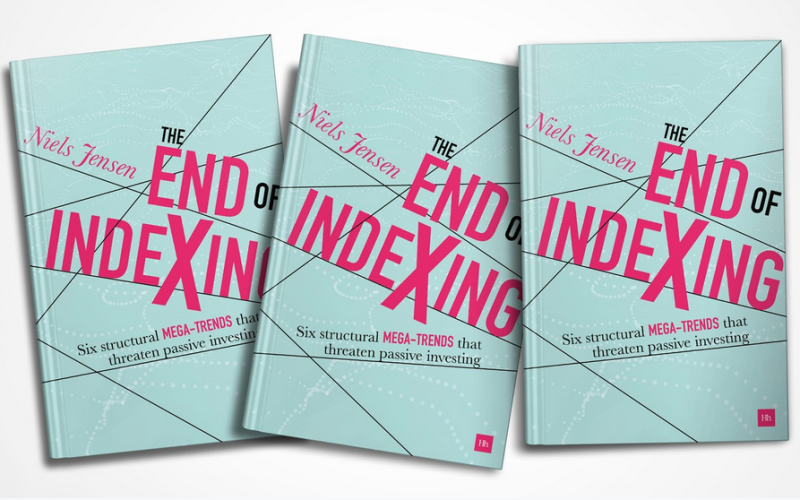by Niels Clemens Jensen, Absolute Return Partners
The dumbest reason in the world to buy a stock is because it’s going up.
Warren Buffett
My ‘little’ project
It took me a long, long time to write The End of Indexing. From A to Z, including the research I conducted before writing a single line, the project took well over two years. I was in fact so absorbed in the project that I had to promise my wife never to write another book, and she still reminds me of that promise every now and then! That said, the book was, and continues to be, very close to my heart. I still don’t see the logic in investing in all yesterday’s winners, which is essentially what you do when you index your portfolio.
The passive brigade will probably argue that yesterday’s winners are more often than not also tomorrow’s winners, but that is not correct. As you can see in Exhibit 1 below, yesterday’s winners are actually not that often tomorrow’s winners. Only because Information Technology has come out on top in three of the last five years, and because the average investor suffers from recency bias, has that become a widely held view.

Sources: Novel Investor
Thematic investing
Instead, I subscribe to thematic investing. When I invest, I always zoom in on those megatrends we have identified at Absolute Return Partners – trends that are virtually set in stone. I actually think it is akin to only getting the bicycle out of the shed if the meteorologists promise tailwinds all the way. What do I mean by that? Take megatrend #2 in the book – Retirement of the Baby Boomers. We know for certain that, in the years to come, the workforce will shrink in most countries (ex. Africa), and we know that a shrinking workforce always leads to lower economic growth – possibly even negative growth in the worst affected countries. By investing thematically, you position your portfolio accordingly. You identify those investment opportunities that stand to benefit from an ageing populace. You can be a little off timing-wise, but you cannot be wrong on the overall investment thesis, as that is set in stone. That is what I mean when I talk about taking advantage of tail winds.
Since writing the book, I have made some modest changes to ‘my’ collection of megatrends, but the gist of it is unchanged. Megatrends are long-term in nature, and one shouldn’t fiddle with them on a regular basis. If you click here, you can see a snapshot on how we present our megatrend philosophy today.
There are two reasons I am writing these lines. A longstanding reader of the Absolute Return Letter, who has also read the book, sent me an email back in May saying (and I quote): “Have you published any updates on the information in the book? If not, I assume the events of the past few months would indicate we are finally at the end [of indexing].” That question definitely deserves a response.
Secondly, I have recently added megatrend #7. It is a trend that has been brewing in the back of my head for a few years, but I couldn’t quite make up my mind – couldn’t see a convincing argument that what was most definitely a trend was also powerful enough to be classified as a megatrend. Russia’s decision to invade Ukraine pushed me over the line. The trend in question is the fact that more and more people turn their backs on globalisation. Inspired by a former colleague of mine, my first inclination was to call this trend “From Globalisation to Localisation” but, on further reflection, I think that is an oversimplification of what is actually going on. In the end (with a little help from my colleagues), I chose to call it “Globalisation 2.0”. A few weeks ago, subscribers to ARP+ received the paper. If you subscribe to ARP+ but haven’t read it yet, I suggest you do so. You can find it here.
You may wonder what Globalisation 2.0 has to do with Russia’s decision to invade Ukraine, and the answer is that western powers are now busy reducing their reliance on countries they don’t wholeheartedly trust. Long after the guns have fallen silent in Ukraine will policy makers all over the world remember this incident, and they will do their best to reduce the exposure to rogue regimes. In the eyes of most policy makers in the west, any country that is not a well-functioning democracy is a rogue regime, and that is why the Chinese should be seriously concerned how the war in Ukraine could affect them.
Mean reversion of wealth-to-GDP
Megatrend #8 on our list is not really a megatrend but rather the likely outcome of the seven megatrends we have identified. For those of you who do not follow our work closely, let me remind you what #8 says:
Mean Reversion of Wealth-to-GDP
In other words, total wealth in society when measured as a percentage of GDP, is out of whack and must, sooner or later, revert to its mean value. Why is that? For reasons I explain here (the link can only be accessed by ARP+ subscribers), wealth-to-GDP varies modestly from country to country but is long-term stable everywhere. It varies (modestly) as capital is not deployed equally efficiently everywhere. The more efficient capital is deployed, the higher the equilibrium value of wealth-to-GDP is. In the US, the long-term mean value is about 380%. Now, because of an extraordinarily friendly Fed, starting with the Greenspan put in the 1990s, and exceptionally low interest rates and QE in the 2000s and 2010s, the appetite for risk assets has been extraordinarily high in the US.
This has led to an astonishing rise in overall wealth-to-GDP over there, which is now hovering around 620% (Exhibit 2). In other words, total US wealth will have to fall nearly 40% unless the correction takes place through the denominator. In that case, US GDP will have to grow faster than US wealth for many years before equilibrium has been re-established.

Sources: Federal Reserve Bank, MacroStrategy Partnership LLP, Absolute Return Partners
Now, three ‘pockets’ make up most wealth all over the world, and that is property, pension savings and equity investments (whether private or public). In terms of asset classes, that makes property, bonds and equities the key drivers of wealth in most countries. Unfortunately, the economic theory behind all of this says nothing about timing and nothing about which asset class that is likely to take the biggest hit. Your only guideline is common sense.
In terms of timing, the best guideline I can think of is the Japanese bubble in the late 1980s. I know one or two people who, in 1986-87, correctly predicted that Japan was on the road to financial disaster; yet, they still lost their jobs for being too pessimistic, as it took much longer than predicted for the meltdown to happen. Could the same be the case in the US now? It is not entirely impossible. Risk assets cannot go up forever, and they will not do so.
As far as financial damage is concerned, which of the three asset classes is likely to take the biggest hit – bonds, equities or property? Given how much government debt has risen since the last financial crisis, it can be assumed that governments all over the world will fight tooth and nail for it not to be bonds that take one for the team. A bloodbath in global bond markets will almost certainly lead to more than one sovereign default. You should therefore expect all tricks in the book to be used to keep interest rates at manageable levels.
That leaves equities and property and is why we invest how we invest at Absolute Return Partners – virtually nothing in residential property and not much in high beta equities either. Whether it takes us 1, 3, 5 or 10 years to be proven correct doesn’t bother us. As long as we can find low-beta strategies that deliver respectable returns, we are happy.
Final few words
The world of 2022 is dramatically different from the world I looked into in late 2017, when I handed in the manuscript to my publisher, Harriman House. In 2017, WTI averaged $51, Brent a few dollars higher. US inflation was a touch above, EU inflation a touch below, 2%, and the UK was still a member of the EU. Now, less than five years later, none of that is the case anymore.
Back in late 2017, if you had been told that WTI would trade below zero in early 2020 only to rise to levels well above $100 only two years later; that US consumer price inflation would be over 8% in mid-2022, but that the S&P 500 would still be 50% higher than in December 2017, would you have believed it? Probably not, but that is nevertheless the case, hence why the current episode of mania reminds me of Japan in the late 1980s.
One of my favourite newsletters of all time is The Credit Strategist, written by Michael Lewitt. He recently wrote a piece called The Ruin of Politics, which you can find here. Michael points out, and I agree, that the Fed – and, by implication, central banks all over the world – have dug themselves a hole so deep that it will take more than most investors expect to dig themselves out again. He provides evidence of that by pointing out how dramatically Wall St. has outperformed Main St. in the bubble economy, and that is precisely why we either have reached, or are about to reach, the End of Indexing.
Niels C. Jensen
1 July 2022















